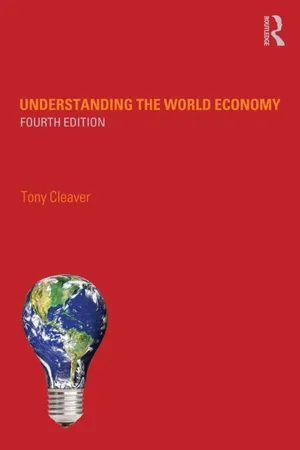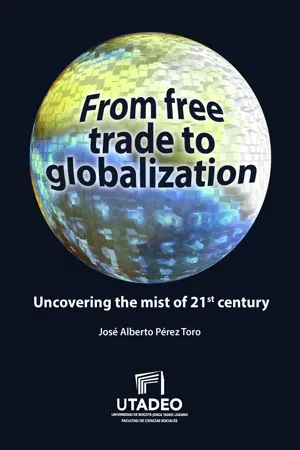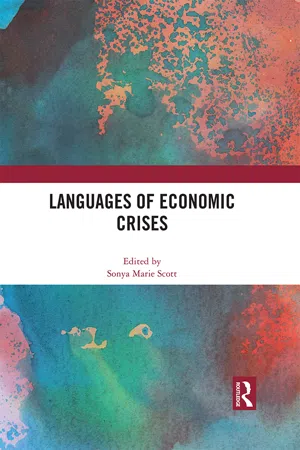Economics
Currency Crisis
A currency crisis occurs when a country's currency experiences a sudden, sharp decline in value, often leading to financial instability. This can be triggered by factors such as high inflation, excessive government debt, or a loss of investor confidence. Currency crises can have significant economic and social impacts, including inflation, unemployment, and reduced living standards for the affected population.
Written by Perlego with AI-assistance
Related key terms
Related key terms
1 of 4
Related key terms
1 of 3
6 Key excerpts on "Currency Crisis"
- eBook - ePub
- Peter Montiel(Author)
- 2013(Publication Date)
- Routledge(Publisher)
Other countries were not so fortunate. Russia, Ecuador, and Argentina, for example, all experienced triple crises, including sovereign defaults. Ecuador’s crisis began as a banking crisis, but spread into a sovereign debt crisis. The crises in Russia and Argentina, by contrast, both began as sovereign debt crises. The fiscal situations of all three countries were precarious enough that when the high interest rates – associated with doubts about their governments’ ability to service their debts, with speculative pressures on domestic currencies, and with perceived fragilities in their domestic financial systems – reached sufficiently elevated levels, their governments found it politically impossible to continue to service their debts. The Russian and Argentine banking systems, though performing very differently prior to their countries’ respective crises, were both largely brought down by their extensive direct exposure to government debt.The Ecuadorian crisis, however, probably provides the most dramatic example of the dynamics of triple crises. Ecuadorian banks lacked an adequate capital cushion and carried risky assets in their portfolios; the country’s central bank had a limited stock of foreign exchange reserves; and its government was highly indebted, suffered from fiscal rigidities, and had a prior history of default. In this context, shocks to the economy in the forms of deteriorating terms of trade, natural disasters, and political instability led to a growth slowdown that aggravated banking sector problems, triggering flight from the currency and raising doubts about the government’s ability to service its debt. Currency mismatches in the balance sheets of the banks and their loan customers, and a large stock of foreign-currency government debt, in turn caused the deteriorating currency to impair the solvency of both the banking system and the government, which reinforced incentives to fly both from the currency and the banking system. Because currency depreciation was the key channel of transmission among the three types of crises, dollarization was adopted in the end to abort these destructive dynamics.12.3 Dealing with crisesWhat lessons do we learn from these ten experiences about dealing with crises once they happen? I conclude this chapter by suggesting lessons in five areas: fiscal policy, monetary policy, financial sector policy, external liquidity provision, and dissolving political stalemates.12.3.1 Fiscal policyThe crises in Argentina and Asia provided evidence that engineering an expansionary fiscal consolidation is difficult to do. Fiscal consolidation is supposed to trigger an expansion by restoring confidence in the government’s solvency and thus lowering domestic interest rates. But in Argentina the lost confidence did not prove easy to restore, and in Asia confidence may not have been lost in the first place. In both cases, contractionary fiscal measures appear merely to have aggravated ongoing recessions. These recessions made the economies involved poor credit risks and aggravated capital flight and exchange rate depreciation. Indeed, exchange rates stabilized in Indonesia, Korea and Thailand only after IMF programs were revised to accommodate looser fiscal targets. - eBook - ePub
Economic Lessons from the Transition: The Basic Theory Re-examined
The Basic Theory Re-examined
- Daniel R. Kazmer, Michele Konrad(Authors)
- 2016(Publication Date)
- Routledge(Publisher)
Central bankers do not like this, because they lose foreign exchange reserves and all they gain are domestic government bonds. Furthermore, central banks do not always have enough foreign exchange to pay for all domestic money presented to them. Sometimes the central bank runs out of foreign exchange. When this happens, the bank cannot maintain its fixed exchange rate, the value of the domestic currency plummets, and a Currency Crisis occurs.The 1990s were filled with exchange rate crises, not confined to small or vulnerable economies. The British pound, the Italian lira, and the Swedish koruna were forced out of the Exchange Rate Mechanism (a European system of fixed exchange rates) in 1992. There followed the Mexican peso crisis of 1994, the Asian financial crisis of 1997 (which started with the Bulgarian crisis in the spring of 1997), the Russian crisis of 1998, followed by mini-crises in Ukraine and Kazakhstan in 1999, the Brazilian crisis of 1999, and the Argentine crisis of 2000–2002.These crises were a surprise to experts and investors alike. They should not have occurred. We believe that basic flaws in the theory of exchange rate determination, as presented in undergraduate texts and summarized above, are the reason. The theory did not serve well for the period of transition in the 1990s, and it will not serve any better in the future.First, much international trade (most oil contracts, for example), is conducted in U.S. dollars. This is true even when there is no U.S. actor in the transaction. For the current theories of exchange rate determination to work, each country’s sellers need to require payment in their home currency, or to convert payments received into their home currency. Further, as we noted in the section on monetary policy, the home currency may not be serving as a store of value and means of exchange even within the country, so that an exporter may use U.S. dollars or another “strong” currency even within his home country. This breaks the link between home country transactions and demand for home currency. - eBook - ePub
- Jessica James, Ian Marsh, Lucio Sarno, Jessica James, Ian Marsh, Lucio Sarno(Authors)
- 2012(Publication Date)
- Wiley(Publisher)
Part IV FX MARKETS AND POLICY Chapter 25 A Common Framework for Thinking about Currency Crises Robert Flood University of Notre Dame Nancy Marion Dartmouth College Juan Yepez Albornoz University of Notre Dame 25.1 Introduction There are two schools of thought concerning economic crises in general and currency crises in particular. In the first, the pre-1978 orthodoxy, economic crises are attributed to arbitrary big shifts in expectations or sudden large disturbances. This view of crises is intellectually comfortable because it associates a big effect with a big shock. Moreover, since the roots of the crises are either outside the realm of economics or due to large unforecastable disturbances, there is little additional work to be done by empirical economists tracing crises back to economic fundamentals. We credit Mackay (1852, reprinted in 2008) and Kindleberger (1978, reprinted in 2000) and other secondary-sourced compilations of amusing anecdotes with developing and preserving this mindset. 1 The second school, which we call the fundamentals approach to crises, was developed by researchers working at the Board of Governors of the Federal Reserve System (the Fed) in the late 1970s and early 1980s. 2 This approach was pioneered by Salant and Henderson (1978) (S&H), who challenged orthodoxy by developing a model of a predictable crisis in which speculators' self-interest leads to market-based dismantling of unsustainable government policies. In the S&H fundamentals approach, there is still room for big shocks to have big effects—but observing a crisis does not necessarily lead researchers to look for big precipitating shocks or arbitrary and self-serving or self-fulfilling expectations shifts - eBook - ePub
- Tony Cleaver(Author)
- 2013(Publication Date)
- Routledge(Publisher)
The Economist, 18 February 1995). The fact that a number of developing countries were still stuck with disabling debt and zero growth was not so important – the overriding concern was to limit the damage done to international banks.The battle was not won for long, however. In 1994, what started as the Mexican peso crisis quickly rebounded worldwide as nervous international investors tried to liquidate their assets in a number of emerging markets. Then again, in 1997, beginning with the devaluation of the Thai baht, the Asian Currency Crisis erupted in some of the young and high-performing economies of East Asia – previously thought to be models of successful development – and its effects contributed eventually to the Russian debt debacle in the following year. From this, speculative hedge funds failed on Wall Street, and thus the spectre arose again of the possibility of debt default, worldwide contagion and a catastrophic crash of international finance which would hurt the rich as well as the poor.Financial crises tend to be ranked in importance according to the threat they pose to the developed world and the banking systems that underpin it. The end of the twentieth century saw a return to a battle against global financial crisis, therefore – and so the big guns of the US Federal Reserve were brought out at the end of 1998 to fight systemic financial collapse yet again. Billions of dollars were secured to bail out fragile Wall Street institutions that, had they folded, would have brought about economic chaos.You might have thought that with all this evident instability and turmoil in international currency and financial markets, the participants involved would have put in place measures to prevent recurring crises. Not so.The contrast with the first financial crash of the new millennium, in Argentina in 2001, is quite instructive. Many large depositors saw this problem coming and they had time to take evasive action. Thus, the eventual crunch did not present such a great shock to the international community. The fact that banks in Buenos Aires closed their doors against smaller domestic customers whilst their savings were being devalued inside, causing riots on the streets of the Argentine capital, was, again, not so important. Riots did not occur on the trading floors or in the boardrooms of financial institutions across the world. - eBook - ePub
From free trade to globalization
Uncovering the mist of 21st century
- José Alberto Pérez Toro(Author)
- 2016(Publication Date)
- Universidad Jorge Tadeo Lozano(Publisher)
neutral, and macroeconomic stabilization would be successfully achieved...” However, with the crisis that began in the year of 2008, the goodness of these theorems can be useful to correct the effect of the global financial crisis.The dollar’s depreciationEven though the U.S. economy always shows signs of strength by virtue of their wealth and accumulated capital, the only growth trend tends to be defined if the effect of the deterioration of global finance is exceeded and the cost of the wars is diminished. The seminar The Economist of December 4, 2004 entitled “The future of the dollar. Would the passing of the buck?” It was established that the dollar had lost value against hard currencies of the world. In October this currency lost 7% reaching the lowest level against the Euro, which added a 35 percent drop from the year of 2002. Against the yen, has been the point of further decline in relative prices over the past five years. Against a basket of other currencies, including the Chinese Yuan the deterioration of the American currency is equal to 17%, which explains why in Colombia refers to the revaluation.The issue has not gone unnoticed to the director of the Federal Reserve Bank, agency that exalts the danger that poses for foreign investors, direct your savings to the American nation against the fact that there is a decrease in returns on your investment in dollar-denominated assets. With the advent of the Crisis of 2008, the trend of the Federal Reserve Bank has been the reduced to zero interest rate, limited this variable to represent the interbank rate and thus preserve a fall in the return on the investments in securities values. - eBook - ePub
- Sonya Marie Scott(Author)
- 2021(Publication Date)
- Routledge(Publisher)
Languages of Economic Crises , hosted in March 2016 at York University (Toronto, Canada), this issue takes an interdisciplinary approach to the way in which language narrates, constitutes, and resists crisis in its many manifestations. For just as ‘crisis’ expresses more than market crashes and panic in the financial core, language itself extends beyond the growing lexicon of terms used to explain or categorize the financial technicalities and social consequences of crisis.This issue opens up to explore languages of debt, languages of austerity, and languages of popular resistance. Language gives an account of crisis and narrates possible futures, both austere and otherwise. Yet many feel disenfranchised from economic debate because they are excluded by the technical language of economics, a language which tends to employ high-level mathematics or the complex terminology of academic texts. Given these exclusionary functions of economic language, it is particularly pressing in periods of crisis that language be examined in its connection to current economic relationships and struggles.While there has been extensive scholarship of the GFC, often inducing amongst academics what Bryan et al . (2012 ) termed ‘crisis fatigue’ and ‘finance overload,’ there is far less current scholarship on the relationship between language and economic crises. Certainly many have followed in the tradition of Norman Fairclough (1989 , 2010 ), engaging in critical discourse analysis in order to explore the relationship between the structure of capitalism and language itself. And while there is indeed work on the history of economic crisis as a concept and its significance for economics (Kindleberger 2005 , Lawson 2009 , Besomi 2012 , Shaikh 2016 ) or on the use of language as business rhetoric during times of crisis (Armenic et al . 2007, López and Llopis 2010 , Tourish and Hargie 2012
Index pages curate the most relevant extracts from our library of academic textbooks. They’ve been created using an in-house natural language model (NLM), each adding context and meaning to key research topics.
Explore more topic indexes
Explore more topic indexes
1 of 6
Explore more topic indexes
1 of 4





